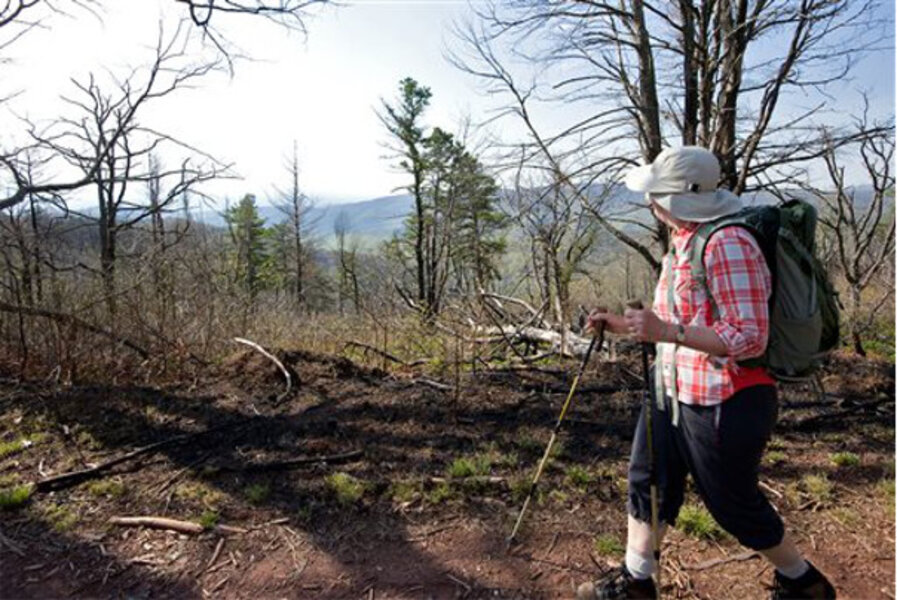Oil and gas decision in GW National Forest: Fracking, yes. Drilling, some.
Loading...
| NORFOLK, Va.
Environmentalists and energy boosters alike welcomed a federal compromise announced Tuesday that will allow fracking in the largest national forest in the eastern United States, but make most of its woods off-limits to drilling.
The decision was highly anticipated because about half of the George Washington National Forest sits atop the Marcellus shale formation, a vast underground deposit of natural gas that runs from upstate New York to West Virginia and yields more than $10 billion in gas a year.
The federal management plan reverses an outright ban on hydraulic fracturing that the US Forest Service had proposed in 2011 for the 1.1 million-acre forest, which includes the headwaters of the James and Potomac rivers. Those rivers feed the Chesapeake Bay, which is the focus of a multibillion-dollar, multistate restoration directed by the Environmental Protection Agency.
A total ban would have been a first for America's national forests, which unlike national parks are commonly leased out for mining, timber, and drilling. But some environmentalists were pleased that at least some balance was struck between energy development and conservation.
"We think the decision shows the Forest Service listened to the local community," said Sarah Francisco, leader of the Southern Environmental Law Center's national forests and parks program. "The vast majority of the forest is protected in this decision."
With both sides lobbying hard, Virginia's Democratic Gov. Terry McAuliffe told his climate change panel in September that federal officials had assured him fracking was off the table. "I won't allow it as long as I'm governor," he said.
But the final word rested with Ken Arney, a regional Forest Service manager. And by Tuesday afternoon, well after the decision was announced, the governor wasn't commenting.
"We think we've ended up in a much better place, which is we are allowing oil and gas drilling," said Robert Bonnie, the undersecretary for national resources and environment at the US Department of Agriculture, which oversees the Forest Service.
"From a policy perspective, the Forest Service allows fracking on forest lands throughout the country. We didn't want to make a policy decision or change policy related to fracking," Bonnie told The Associated Press in a telephone interview.
The new plan eliminates the potential for oil and gas leases on 985,000 acres where they could have been granted, and permits drilling only on 167,000 acres with existing private mineral rights and 10,000 acres already leased to oil and gas companies. The private mineral rights are scattered throughout the forest, which hadn't updated its management plan since 1993.
This lobbying fight was mostly over principle, since no energy company has wanted to actually drill on the land they're leasing, Bonnie acknowledged. "The economic value of these reserves is very low. We've had very little interest on oil and gas on the forest," Bonnie said.
Also, more environmental analysis and public comment would be encouraged before any drilling is approved, the Forest Service said.
Fracking enables the extraction of oil and gas from otherwise marginal shale deposits by injecting water mixed with chemicals and sand or gravel deep underground at extremely high pressure.
Environmental groups fear the drilling and its waste could pollute mountain streams that directly provide drinking water to about 260,000 people in the Shenandoah Valley. Another 2.7 million people in Northern Virginia and Washington get part of their drinking water from the forest.
"The risks of fracking are well documented, from water, air, and climate pollution to the industrialization of special places," Glen Besa, director of the Sierra Club's Virginia chapter, said in a statement.
"Unfortunately, these risks remain for the existing leases in the forest. While the leases may be low value, they are certainly high risk."
Opponents also argued that the trucks, wells and other infrastructure that would come with gas drilling are incompatible with the forest's primary attractions of hiking, fishing, hunting, camping, tourism and its abundant wildlife. The forest includes a section of the Appalachian Trail and attracts more than 1 million visitors annually.
The American Petroleum Institute maintains that hydraulic fracturing can be done safely and without risk to groundwater, but the science has not been conclusive.
"Natural gas is an enormously versatile fuel that helps power our nation's economy. Horizontal drilling and hydraulic fracturing is helping to unlock the tremendous economic and job creation benefits that Virginians, and all Americans, need and want," Virginia Petroleum Council Executive Director Michael Ward said in a statement.







